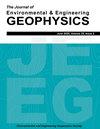俄罗斯西伯利亚西部高度大陆性气候下废弃矿山尾矿的时移电阻率层析成像和土壤气体测量
IF 0.7
4区 工程技术
Q4 ENGINEERING, GEOLOGICAL
引用次数: 2
摘要
尾矿是一个非常活跃的系统,在这个系统中,物质的氧化、溶解和再沉积过程都是实时发生的。在俄罗斯西西伯利亚高度大陆性气候下,对废弃矿山尾矿进行了延时电阻率层析成像和土壤气体测量。电阻率层析成像法可以确定尾矿的结构,即其电物性参数,这些参数与地下物质的化学组成和地球化学特征有关。这项工作的目的是确定含硫化物矿山尾矿地电分带的变化,这取决于环境条件的波动,即地面和空气温度,以及从尾矿中散发的与环境有关的挥发性化合物(SO2、CS2、C2H6S)。每小时的观测显示,地电剖面的结构在白天发生变化。大气表层气体浓度随环境温度的变化而变化。一般来说,最低气体浓度是在夜间测定的,当温度升高时,气体浓度开始增加。在白天和夜间,气体形成对温度条件的依赖性不同。在温暖的时间里,气体浓度最高。在夜间,当空气温度先下降后地面温度下降时,在空气温差最大时(14.1°C),所有测量气体的浓度都出现局部升高,地面保持相对温暖(20.8°C)。地温、电阻率和产气速率之间有密切的关系。电阻率变化最大的局部异常与气体辐射最活跃的区域有关。本文章由计算机程序翻译,如有差异,请以英文原文为准。
Time-Lapse Electrical Resistivity Tomography and Soil-Gas Measurements on Abandoned Mine Tailings Under a Highly Continental Climate, Western Siberia, Russia
Mine tailings are a very active system in which the processes of oxidation, dissolution, and the re-deposition of substances occur in real-time. Time-lapse electrical resistivity tomography and soil-gas measurements have been used on abandoned mine tailings under a highly continental climate, Western Siberia, Russia. The electrical resistivity tomography method allows the structure of the tailings to be determined, namely, its electrophysical parameters, which are related to the chemical composition and geochemical characteristics of the subsurface substance. The aim of this work is to determine the variations in the geoelectrical zoning of sulfide-bearing mine tailings depending on fluctuations in environmental conditions, i.e., ground and air temperature, in conjunction with volatile compounds of environmental concern emanating from the tailings (SO2, CS2, C2H6S). The hourly observations revealed that the configuration of the geoelectrical section varies during the day. The concentration of gases in the surface air layer varied in accordance with the ambient temperature conditions. In general, the minimum gas concentrations were determined at night, and the increase in gas concentrations began when the temperature increased. The dependence of gas formation on temperature conditions differed during the daytime and nighttime. In warmer hours, gas concentrations are highest. At night, when there was a decrease in the temperature of air and then in the ground temperature, a local increase in the concentration of all measured gases occurred at the maximum temperature difference in the air (14.1 °C), and the ground remained relatively warm (20.8 °C). There is a close relationship between ground temperature, electrical resistivity, and the rate of gas production. Local anomalies with the greatest variation in electrical resistivity are associated with the zones that have the most active gas emanations.
求助全文
通过发布文献求助,成功后即可免费获取论文全文。
去求助
来源期刊

Journal of Environmental and Engineering Geophysics
地学-地球化学与地球物理
CiteScore
2.70
自引率
0.00%
发文量
13
审稿时长
6 months
期刊介绍:
The JEEG (ISSN 1083-1363) is the peer-reviewed journal of the Environmental and Engineering Geophysical Society (EEGS). JEEG welcomes manuscripts on new developments in near-surface geophysics applied to environmental, engineering, and mining issues, as well as novel near-surface geophysics case histories and descriptions of new hardware aimed at the near-surface geophysics community.
 求助内容:
求助内容: 应助结果提醒方式:
应助结果提醒方式:


